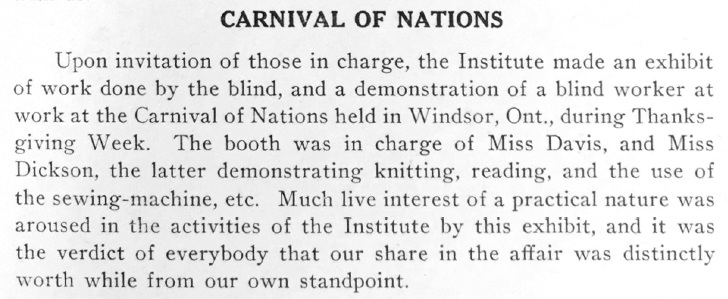Written by Jessica Watkin
Click on an image to enlarge.
Founded in 1918 at the end of the First World War, the Canadian National Institute for the Blind (CNIB) devoted its first year to engaging both the public and a small blind community mainly made up of veterans. The organization provided rehabilitation services for blind and partially blinded people in Ontario while focusing on creating living and working opportunities for Toronto’s blind community. Exploring the particular needs and varying conditions of blind people, the CNIB developed programs and staff positions that still serve as the primary structure of the organization that continues to support blind people across Canada.
The Bulletin, first published in October 1918, served as a public notice for changes within the organization, its staff and board, and the programs in development. I discovered this publication after a trip to the CNIB archives where my experience went beyond the visual; it became a tactile search through an extensive collection of braille documents spanning the last hundred years of the organization. Held at Library and Archives Canada, The Bulletinwas generously shared by Jane Beaumont, CNIB’s current Archivist, upon preparations for the 2018 centennial celebration of the organization. Beaumont and her team created a “living history” exhibit based on these documents and many others like them to celebrate the conception of the organization, its growth and its future (visit the special online exhibit by clicking the link below).
The November 1, 1918 issue of The Bulletindescribes an exhibit in which blind people show “what they can do” at a local event called “Carnival of Nations.” The carnival featured blind people performing activities in a curated setting. While this exhibit may invite comparisons to the more popular freak show of the late 19thand early 20thcenturies, the CNIB’s efforts centered on advocacy, showing blind people successfully doing “normal” things. These performances are the first recorded instances of shared experience between the private and public lives of blind Canadians and the general public in Toronto, which also suggests a context and relationship between the two. The need for blind Canadians to “prove” their competence while also showcasing their exoticized private lives gives us a glimpse into the CNIB’s understanding of public attitudes towards blind people; this is what needed to happen for their experiences to be understood and supported by the public. While the organization has developed extensively over the last 100 years it continues to showcase blind skills today in various ways.
An example of this would be in the November 1, 1918 issue pictured here The Bulletin editors chose to showcase an exhibit in which blind people show “what they can do” at a local event called “Carnival of Nations”. Real blind people performing real blind activities in a curated setting, possibly a small hint of freak show, but more prominently the CNIB gravitates towards advocacy in showing a successful blind person doing those “normal” things. These performances act as the first recorded instance of shared experience between the private and public lives of blind Canadians and the public in Toronto, but also suggests a context and relationship between the two as well. The need to “prove” their competence while also showcasing their exoticisized private lives creates an idea of what the CNIB believed the public thought of blind people, but also possibly hints at what needed to happen in order for their experiences to be understood and supported. The organization has developed over the last 100 years but continues to showcase blind skills today in various ways.
In the May 1, 1919 issue of The Bulletin, the editors announced the inclusion of blind persons in the Royal Ontario Museum (ROM) through a sensory experience of artifacts in its collection. The museum’s guided and tactile tours of exhibits act as a performance history: an experience that introduces blind people to historical artifacts previously understood through vision. The excerpt above reveals that CNIB’s advocacy within the community integrated performative qualities within everyday experience, enlivening the museum visit that is otherwise passive. The tactile tours at the ROM have developed over the past 100 years and remain a key part of blind culture and inclusion in Toronto today (blind patrons can request a tour at any time). These interactive explorations of exhibits have now been integrated into the patron experience, extending this particular performance history to the general public and normalizing the inclusion of blind people in Toronto’s popular culture.
Link to CNIB’s special online exhibit: http://thatallmayread.ca/explore-history/

